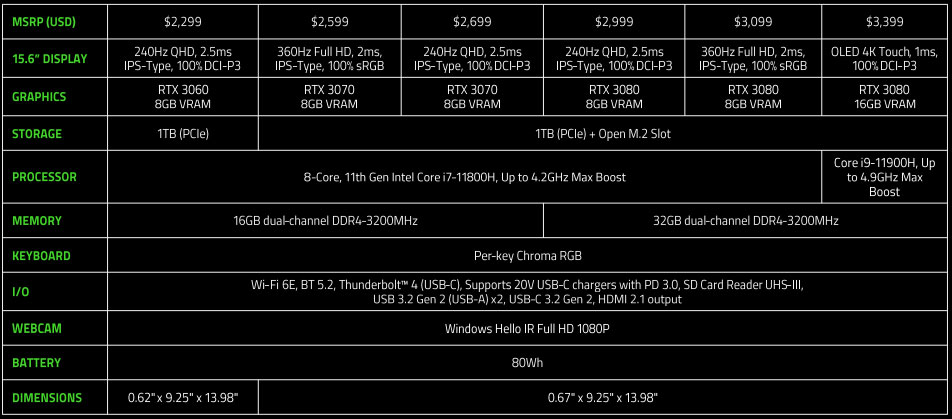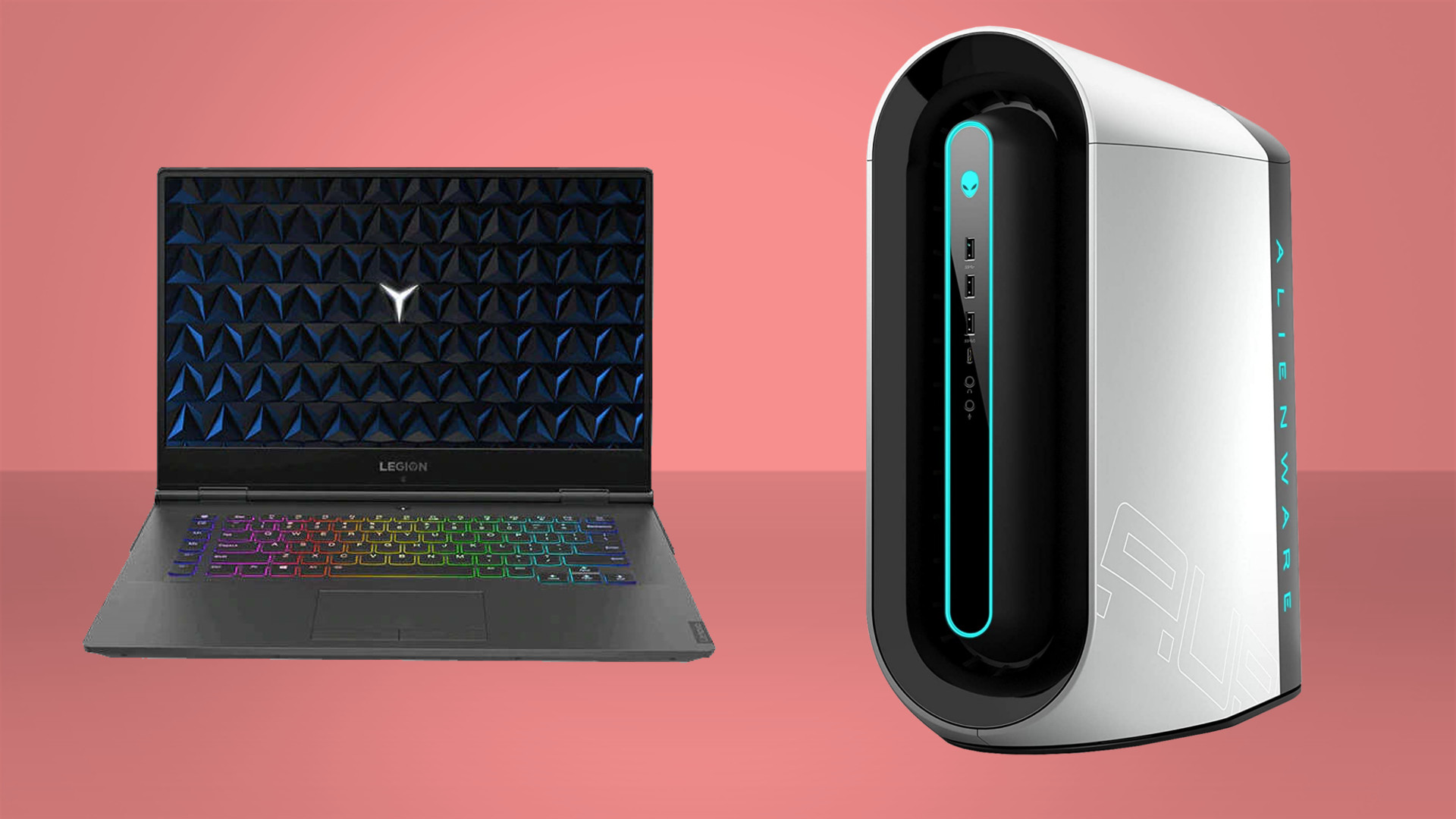Razer upgrades its Blade 15 laptops with Tiger Lake-H and up to a 360Hz display
Whenever AMD or Intel launch a new processor line, their hardware partners are quick out of the gate with new systems boasting the latest silicon. And so it goes with Razer and Intel—the former just upgraded its Blade 15 Advanced laptop line with the latter's freshly minted Tiger Lake-H CPUs.
Intel yesterday released five Tiger Lake-H chips, including two 6-core/12-thread Core i5 models and three 8-core/16-thread Core i7 and Core i9 chips. For its latest refresh, Razer opted for two higher end options, the Core i7 11800H (8C16T, 2.3GHz to 4.6GHz, 24MB L3 cache) and the Core i9 11900H (8C16T, 2.5GHz to 4.9GHz, 24MB L3 cache).
The entire Tiger Lake-H stack is equipped with Intel UHD graphics, but we wouldn't crown the Blade 15 the best gaming laptop if it shunned discrete GPUs. And it doesn't—Razer's Blade 15 Advanced leans on discrete GPUs from Nvidia's mobile GeForce RTX 30 series (Ampere).

Pricing for the refreshed models starts at $2,299, which gets a Core i7 11800H paired with a GeForce RTX 3060, along with 16GB of DDR4-3200 memory, a 1TB NVMe SSD, and a 1080p display with a fast 240Hz refresh rate and 100 percent coverage of the DCI-P3 color space.
Note that Razer's spec sheet above has the refresh rate backwards on the $2,599 and $2,699 models—it's the latter that comes with a 360Hz display. Both models also feature a GeForce RTX 3070 GPU, and the storage and RAM as the $2,299 model.
The rest of the models ($2,999 and up) bump up to Nvidia's flagship mobile GPU, the GeForce RTX 3080, while also doubling the RAM to 32GB. They come with an extra M.2 slot for expandable storage, too.

Best gaming PC: the top pre-built machines from the pros
Best gaming laptop: perfect notebooks for mobile gaming
Oddly enough, the i9 11900H option is only available with the 4K model. On the plus side, there shouldn't be a monumental gap in performance between it and the i7 11800H—the higher end CPU has a 200MHz faster base clock and 300MHz faster max boost clock. While that's not insignificant, the i7 11800's performance should be within striking distance of its i9 sibling.
Even with all this firepower, taking full advantage of the high refresh rates (240Hz and 360Hz) is a tall ask. They're mostly beneficial for competitive gaming in less demanding titles, where hitting triple-digit frame rates is possible. Nevertheless, we'd rather Razer overshoot than undershoot when it comes to the refresh rates of its laptop screens.
All of the upgraded models are available to preorder on Razer's website and will be properly on sale in the second half of June (adding one the laptops to your cart currently shows the estimated ship date as June 21).
from PCGamer latest https://ift.tt/3fiEX8K
Whenever AMD or Intel launch a new processor line, their hardware partners are quick out of the gate with new systems boasting the latest silicon. And so it goes with Razer and Intel—the former just upgraded its Blade 15 Advanced laptop line with the latter's freshly minted Tiger Lake-H CPUs.
Intel yesterday released five Tiger Lake-H chips, including two 6-core/12-thread Core i5 models and three 8-core/16-thread Core i7 and Core i9 chips. For its latest refresh, Razer opted for two higher end options, the Core i7 11800H (8C16T, 2.3GHz to 4.6GHz, 24MB L3 cache) and the Core i9 11900H (8C16T, 2.5GHz to 4.9GHz, 24MB L3 cache).
The entire Tiger Lake-H stack is equipped with Intel UHD graphics, but we wouldn't crown the Blade 15 the best gaming laptop if it shunned discrete GPUs. And it doesn't—Razer's Blade 15 Advanced leans on discrete GPUs from Nvidia's mobile GeForce RTX 30 series (Ampere).

Pricing for the refreshed models starts at $2,299, which gets a Core i7 11800H paired with a GeForce RTX 3060, along with 16GB of DDR4-3200 memory, a 1TB NVMe SSD, and a 1080p display with a fast 240Hz refresh rate and 100 percent coverage of the DCI-P3 color space.
Note that Razer's spec sheet above has the refresh rate backwards on the $2,599 and $2,699 models—it's the latter that comes with a 360Hz display. Both models also feature a GeForce RTX 3070 GPU, and the storage and RAM as the $2,299 model.
The rest of the models ($2,999 and up) bump up to Nvidia's flagship mobile GPU, the GeForce RTX 3080, while also doubling the RAM to 32GB. They come with an extra M.2 slot for expandable storage, too.

Best gaming PC: the top pre-built machines from the pros
Best gaming laptop: perfect notebooks for mobile gaming
Oddly enough, the i9 11900H option is only available with the 4K model. On the plus side, there shouldn't be a monumental gap in performance between it and the i7 11800H—the higher end CPU has a 200MHz faster base clock and 300MHz faster max boost clock. While that's not insignificant, the i7 11800's performance should be within striking distance of its i9 sibling.
Even with all this firepower, taking full advantage of the high refresh rates (240Hz and 360Hz) is a tall ask. They're mostly beneficial for competitive gaming in less demanding titles, where hitting triple-digit frame rates is possible. Nevertheless, we'd rather Razer overshoot than undershoot when it comes to the refresh rates of its laptop screens.
All of the upgraded models are available to preorder on Razer's website and will be properly on sale in the second half of June (adding one the laptops to your cart currently shows the estimated ship date as June 21).
via IFTTT

Post a Comment